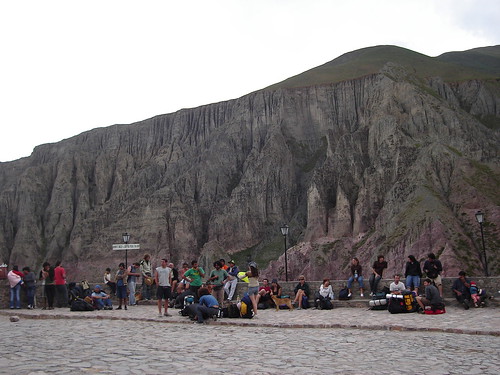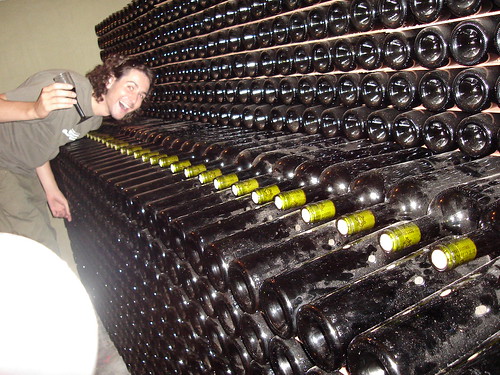![]()
"The Gringo Trail" is a phrase South American travellers use often. It refers to the long chain of cities and destinations that North American and European travellers tend to visit. Even though we all fancy ourselves to be rugged individuals ultimately we're a big group of individuals often visiting the same places so we often run into eachother, over and over, along the way. When we met long term travellers in Central America one of the first questions asked is "are you going North or South?" Tyler and I were headed south, so when we met someone going north we grilled them with questions about where we should go next because they probably had similar interests. When we met someone also going south, we almost always knew we had previously visited some of the same cities, the same places in the same order. Furthermore, when it came time to say goodbye we'd do so with a smirk, knowing that we might run into eachother again along the way. The gringo trail isn't as straightforward in South America, now that east and west are options, but it exists nonetheless. Almost anyone who goes to Peru goes to Lima, Cuzco and Machu-Pichu and if they made the trek into Bolivia we might see them again at Lake Titicaca or Salar de Uyuni. The trail is exciting because it is determined by the cool destinations but Tyler and I discovered, several times, that sometimes things are even better off the trail.
![]()
It's easy, while on the trail, to forget that the majority of the country your visiting is different. Off the trail it's hard to find English speakers, organized trips and familiar food. I've been thinking this a lot recently because I've been well off of it for about a month now. Travelling with a trio of Argentinian girls has been an entirely different experience than anything else I've done on this trip. Coupling that with the fact that Argentina is itself, in many way, exceptional has lead to a feeling that this is a different trip than the one I was on before.

Some things are similar; there are a lot of shaggy travellers with a wanderlust. More so than any other Latin American nationalities young Argentinians, it turns out, love to move. Everywhere I looked while wandering around Jujuy I see scores of new Che Gueveras on his youthful journeys. But it's not only men, in about equal measure I constantly see groups of 2-5 (
lovely!) girlfriends seeing the world together. I can't imagine what I did to be this lucky, perhaps I cured a major disease in a former life, but I got to travel in one of these groups with Pato and two other Porteñas (women from Buenas Aires) all over Jujuy.
![]()
The small provence of Jujuy is not on the Gringo trail, it barely recieves three pages in our travel guidebook but having been there I have no idea why not.
![]()
It's on the top of Argentina, where the high Andes of Bolivia plow into Argentina before dramatically plunging down into the lower plains. In one small area we found 4 very different climates. One day we were in the tiny low elevation town of San Francisco, pushing our way through thick rainforest jungle while on an Indiana Jones-esque adventure.
![]()
And then the next day, and a few hours on a bus later, we saw the much more arid town of Pulmamarca. In addition to seeing traditional dances on the center square we saw entire mountains painted with such impossible colors its hard to concieve. From there, an hour on a bus took us to high altitude lakes of salt. We visited countless small towns, a medium sized city, and constantly drank in mountain geology unlike anything I've ever seen. This region is mostly undiscovered by Gringos like myself but is far from undiscovered. The low cost of living, plethora of unique cultures and spectacular scenery draws Argentinian travellers like moths to a flame.
It's been a well needed, but nonetheless difficult, workout for my Spanish. Not only has my meager vocabulary been pushed beyond its limits, but just to complicate my life Argentina has a much faster and much different accent. For example, instead of pronouncing "-y-" and "-ll-" with a
y sound, like everyone else, the Argentinians use a
sh sound. So words I've long been comfortable with, like "Yo" (
I), are suddenly hard to recognize in a conversation. But I'm getting it, slowly but surely, and despite triggering much laughter along the way patient folks along the way have coached me along. I've found it to be better than any spanish class to sip maté and try to stay engaged in a conversation. Partly, because the topics are more interesting and fun. But mostly because I'm quickly becoming hooked on maté!
![]()
Maté is a decidely Argentinian and Uruguayan tradition. It's a kind of tea, called Yerba, that you fill a special cup with. After adding about a quarter cup of near boiling water to the mix, you sip it with a special straw that filters out the tea (Sampa, the guy on the left in the picture to the left, is drinking maté). After sipping it all, the Maté gets refilled and passed to the next person in the circle (or the closest stranger, as this is a tradition that makes friends with everyone in Argentina). Every group of Argentinian travellers always has at least one steel thermos of hot water with them so they can be prepared for maté on a moments notice. Maté itself has a strong bitter, taste (although some add sugar) and has a reviving affect not unlike coffee. I like the taste, and the effect, but I really love the tradition. It's a great excuse to sit in a park with friend and talk while the cup goes around. But, its nearly as easy to sit in a park alone and offer a cup to a stranger as an excuse to start a conversation.
![]()
Conversations with newfound friends have been great and I've finally begun to think in Spanish enough to not be constantly translating in my head. I've been a little more engaged in the culture I'm in and learning a lot more. Particularly, not surprisingly, learning a lot more about Patricia. The day we met in Granada was great, but over the last month I keep shaking my head in disbelief that there was
so much I didn't know about her. Now she is finishing up her studies of Psychoanalysis, focused on working with kids, but has a history more varied than my own. She has worked as a waitress, studied theater and spent years working as a circus performer. She was an only child to older parents in a country with a long and troubled history and grew up (and still lives) in one of the worlds most vibrant cities. But despite the differences in histories we've found a lot in common an urge to stand apart from groups and an itch to see more of the world. Somehow, when I met her in Granada, I had the impression she was a lovely and fun but mostly superficial person. I was still looking forward to re-meeting her but when I did I was shocked to find myself in great conversations about literature and life philosophies. It's funny how four years, several thousand miles and a lot more time together can change things.
Another misconception was what I was in for. I was expecting to stick around the small state of Jujuy until we meandered back to Buenas Aires together. I should've realized that I was with another traveler and that she has a bigger appetite to see this country than I. So, after we saw her friends off, we kept moving. But now, having discovered a mutual interest in red wine we were on a mission. Argentina is world famous for it's vineyards and if we take a few long bus trips....



No comments:
Post a Comment